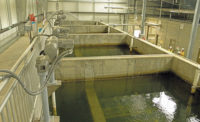Signal Butte Water Treatment Plant
Mesa, Ariz.
Best Project
Owner/Developer: City of Mesa
Lead Design Firm: Black & Veatch Corp.
General Contractor: Sundt Construction
Architect: Brock, Craig & Thacker Architects
Electrical Contractor: Sturgeon Electric
The 24-milion-gallon-per-day plant began operations June 3, 2018, in time to meet summer water demand for a growing segment of Mesa, southeast of Phoenix. The facility reduces the city’s reliance on groundwater wells. As projected, the plant produces 20% to 25% of the city’s water supply. As the area grows, the campus is expandable to a 48-mgd maximum capability, says Michael McBrady, a senior civil engineer for the city.
The 23-acre campus is anchored by a pair of two-story buildings that blend in with the neighborhood and the surrounding desert. The operations building incorporates a butterfly-style standing-seam metal roof above the lobby and high-UV reflective glass clerestory windows. The 16,397-sq-ft masonry-block structure is connected by an overhead walkway to the cast-in-place concrete 33,306-sq-ft treatment complex. The site is xeriscaped and includes an emergency retention basin.
The plant receives raw water through a 54-in.-dia pipe connected to the Central Arizona Project Canal three miles east. It uses ozone, ballasted flocculation, biological granular-activated carbon filtration and onsite generated sodium hypochlorite disinfection. An adjacent 8-million-gallon reservoir and water pump station delivers drinking water 24/7 to residents and industrial users. The system is one of the few in Arizona regularly using ozone twice upstream of biological carbon filtration, McBrady explains.
Crews installed and tested a water-pressure-driven polyurethane foam plug, also known as a pig, possibly the largest ever used in Arizona for water pipeline cleaning. The unit descales and cleans infestations such as quagga mussels from inside the incoming raw-water pipeline.
In addition, because the plant incorporates ballasted flocculation, it requires significantly less land than that needed for conventional water-treatment campuses. This method adds alum, silica sand and polymer to coagulate the raw water, making it heavier and allowing for vertical processing in the two-story treatment plant, thus avoiding land-consuming treatment basins, says Josh Smith, project engineer for Black & Veatch. Because of this, Mesa is using some of the available space to build an adjacent 28-acre park as a recreational buffer between the facility and nearby homes.
Sundt encountered a variety of challenges, including a delay resulting from flooding of the adjacent Siphon Draw Wash from the Superstition Mountains. This was remediated through berming and grading, says Michael Vokoun, the company’s senior project superintendent.
In early design, the project schedule was accelerated to meet the rapidly increasing residential and industrial demand by splitting design into two packages. That allowed for earlier groundbreaking and procurement. For additional time savings on the back end of the project, Black & Veatch developed control-systems software simulations to ensure that plant controls would function as expected on startup and during operation, Smith says.
Back to "ENR Southwest's 2019 Best Projects: Innovation, Skillful Renovations Lauded"








Post a comment to this article
Report Abusive Comment